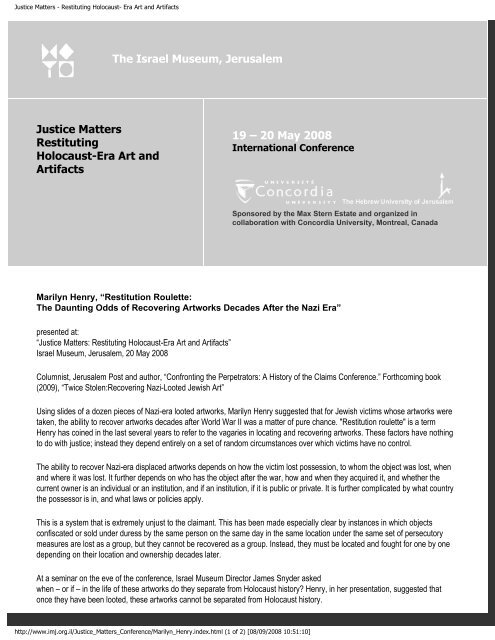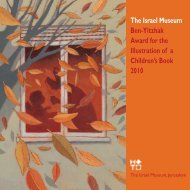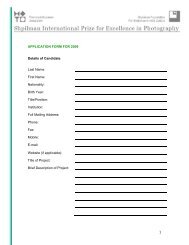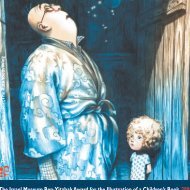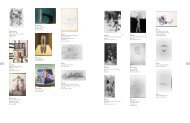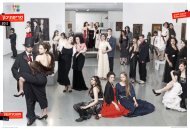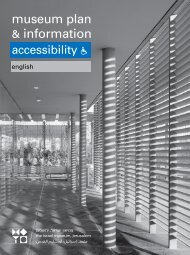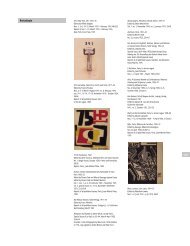Download Pdf - The Israel Museum, Jerusalem
Download Pdf - The Israel Museum, Jerusalem
Download Pdf - The Israel Museum, Jerusalem
Create successful ePaper yourself
Turn your PDF publications into a flip-book with our unique Google optimized e-Paper software.
Justice Matters - Restituting Holocaust- Era Art and Artifacts<br />
<strong>The</strong> <strong>Israel</strong> <strong>Museum</strong>, <strong>Jerusalem</strong><br />
Justice Matters<br />
Restituting<br />
Holocaust-Era Art and<br />
Artifacts<br />
19 – 20 May 2008<br />
International Conference<br />
Sponsored by the Max Stern Estate and organized in<br />
collaboration with Concordia University, Montreal, Canada<br />
Marilyn Henry, “Restitution Roulette:<br />
<strong>The</strong> Daunting Odds of Recovering Artworks Decades After the Nazi Era”<br />
presented at:<br />
“Justice Matters: Restituting Holocaust-Era Art and Artifacts”<br />
<strong>Israel</strong> <strong>Museum</strong>, <strong>Jerusalem</strong>, 20 May 2008<br />
Columnist, <strong>Jerusalem</strong> Post and author, “Confronting the Perpetrators: A History of the Claims Conference.” Forthcoming book<br />
(2009), “Twice Stolen:Recovering Nazi-Looted Jewish Art”<br />
Using slides of a dozen pieces of Nazi-era looted artworks, Marilyn Henry suggested that for Jewish victims whose artworks were<br />
taken, the ability to recover artworks decades after World War II was a matter of pure chance. "Restitution roulette" is a term<br />
Henry has coined in the last several years to refer to the vagaries in locating and recovering artworks. <strong>The</strong>se factors have nothing<br />
to do with justice; instead they depend entirely on a set of random circumstances over which victims have no control.<br />
<strong>The</strong> ability to recover Nazi-era displaced artworks depends on how the victim lost possession, to whom the object was lost, when<br />
and where it was lost. It further depends on who has the object after the war, how and when they acquired it, and whether the<br />
current owner is an individual or an institution, and if an institution, if it is public or private. It is further complicated by what country<br />
the possessor is in, and what laws or policies apply.<br />
This is a system that is extremely unjust to the claimant. This has been made especially clear by instances in which objects<br />
confiscated or sold under duress by the same person on the same day in the same location under the same set of persecutory<br />
measures are lost as a group, but they cannot be recovered as a group. Instead, they must be located and fought for one by one<br />
depending on their location and ownership decades later.<br />
At a seminar on the eve of the conference, <strong>Israel</strong> <strong>Museum</strong> Director James Snyder asked<br />
when – or if – in the life of these artworks do they separate from Holocaust history? Henry, in her presentation, suggested that<br />
once they have been looted, these artworks cannot be separated from Holocaust history.<br />
http://www.imj.org.il/Justice_Matters_Conference/Marilyn_Henry.index.html (1 of 2) [08/09/2008 10:51:10]
Justice Matters - Restituting Holocaust- Era Art and Artifacts<br />
She quoted John Coffey, the curator at the North Carolina <strong>Museum</strong> of Art, speaking at a ceremony when the painting<br />
''Madonna and Child in a Landscape,'' by Lucas Cranach the Elder, was formally reinstated in the museum. This was made<br />
possible by a generous arrangement with the heirs of the pre-war owner, an Austrian industrialist, Philipp von Gomperz, who had<br />
fled the Nazis.<br />
Coffey referred to the Cranach this way: "Religious icon, aesthetic object, war loot, propaganda, commodity, memento, the<br />
elusive object of a quest, and a symbol of hope and reconciliation: this small, exquisite painting has been all of these things. Its<br />
various and contradictory meanings are the product of an extraordinary history. And that history, so full of meanings and itself so<br />
meaningful, is what we intend to share with any and all who are drawn into the wonder of this picture.” Henry suggested this is true<br />
of all Nazi-era looted art.<br />
http://www.imj.org.il/Justice_Matters_Conference/Marilyn_Henry.index.html (2 of 2) [08/09/2008 10:51:10]


